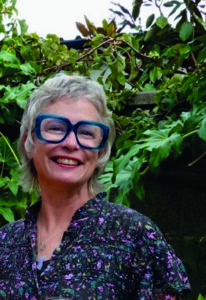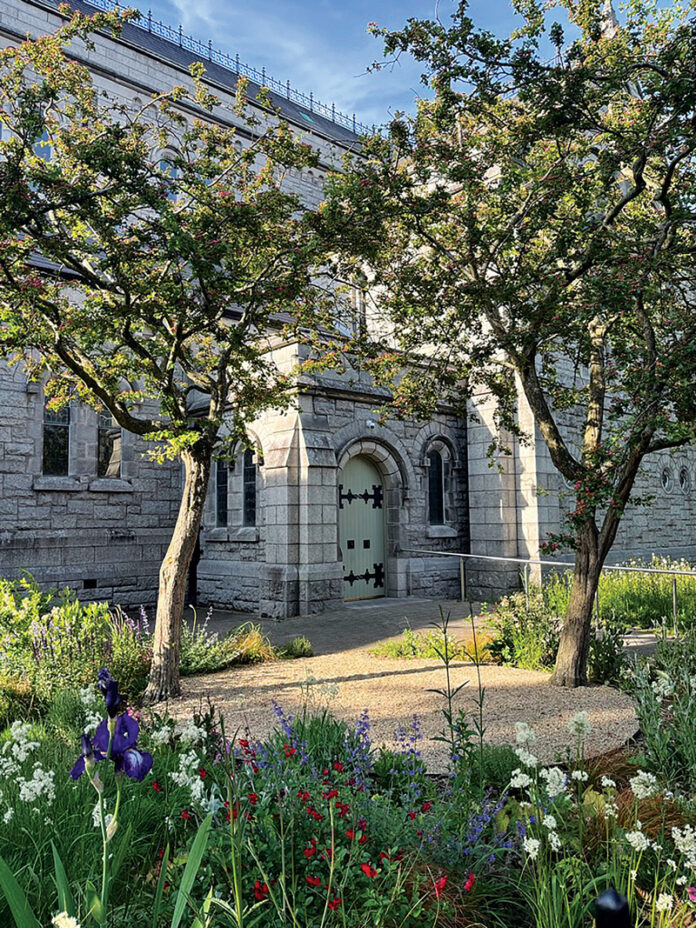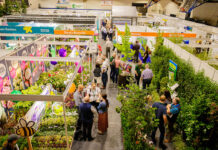It started with a conversation about wildflowers in Dublin’s Ranelagh. Our local catholic church, Church of the Holy Name on Beechwood Avenue, wanted some beauty at the front of the church grounds – maybe a wildflower meadow – rather than plain grass.
That’s usually how new garden design conversations start: a client’s dream of what might be achieved. Our job as designers is to harness the parts of that dream that are practical, and improve on the dream to make it a reality.
This project called for a different approach than my usual garden design service. So I worked within my co-creative collaborative company, called Green Edge, to realise a re-imagined use of this semi-private, semi-public grounds of a place of worship.
My Green Edge co-founder, artist Róisín de Buitléar, and I met with the Beechwood parish council to formalise a brief and to develop a concept.
Covid restrictions had impacted the numbers of congregations attending funerals and other sacraments, so the parish council were exploring using the outdoor church grounds into the future for masses and processions.
Our concept was to create a parish garden that not only put church activities at the centre, but extended those events into the space around the church building, opening the garden to local parishioners. We also wanted the new garden to play a beautiful and natural supporting visual role to the church building.
The brief we developed centred around four main points: increase biodiversity; enhance the beauty of these grounds; improve usability of the space; and budget (value for money must be at the heart of all design decisions).
PATHWAYS TO PARADISE
We called this church grounds redesign project ‘Pathways – a Garden for the Parish’, to acknowledge the wide grass pathways which were pivotal to our design. Our intention was to encourage visitors to stay within specific areas of the garden, and to lead people to larger spaces with different functions, to accommodate a variety of requirements for community groups.
Individuals attending funerals, weddings, christenings, communions and confirmations; as well as groups for prayer, pastoral activities, active retirement, youth and children – all are potential users of the garden.
Local children and dog owners were the most frequent users of the outdoor space. We were keen to encourage increasing respect for the church grounds amongst these existing users, whilst enhancing the garden’s attraction for the wider community. We designed with this in mind.
NURTURING NATURE
Our initial survey examined the existing plants, and asked how hard they were working on this one-acre site. The church grounds’ plants comprised 90 per cent grass, 7 per cent trees – mature limes, a beech, an ash and a horse chestnut – and 3 per cent over-pruned shrubs.
These plants were easy to maintain for the humans on site. However, when we investigated how useful this maintenance plan and its effects were to local bird and insect life, we began to get a different picture of the value of a regular mowing and pruning regime. There were no seeds or flowers for the wildlife to use as food, and little material with which to build nests or to hibernate in.
Providing wildlife habitat formed the basis of our design for the new beds, with robust planting schemes particular to the climatic conditions and aspects of the garden. We increased biodiversity significantly by introducing year-round planting that nurtures and nourishes wildlife.
We cut right back on the grass mowing, and now only cut the pathways through the long grass. We planted a ‘people’s orchard’ at the back of the site, which creates a textural space that changes through the seasons and makes gentle sounds that recall nature in the city.
BEAUTY
The new swathes of planting on the grounds create a softer, more welcoming view through the church railings, and from the entrance ways to the garden within. Practical measures, like a gravel area, allow for access to flagpoles, enabling gatherings to take commemorative photographs, which can now be framed by two arching hawthorn trees with fragrant planting underneath.
The front of the church grounds look gentler now, with perennial planting along the front railings. There is colour all year round, from salvias in summer, echinacea in autumn, ornamental grasses and seedbeds in winter, and tulips and daffodils during springtime.
USABILITY
The parish council wanted a beautiful space with flowers, where people could sit enjoying nature, connecting back to the religious aspect of appreciating all of god’s creation. The council were also concerned not to increase their costs with a whole new high-maintenance planting scheme requiring a full-time gardener.
They were very hopeful that a volunteer gardening group might be formed. Dwindling numbers attending church events and daily mass brought into sharp focus the positive use of this outside space to encourage visitors back into the church community.
Budgetary and attendance concerns impact most places of faith in this country these days. Huge attendance drop-off numbers are leaving many buildings empty, their surrounding grounds falling into disrepair. In the context of our housing crisis, Ireland is re-examining the best use of these spaces that were originally intended for worship.
We need to retain and increase green spaces, especially in urban areas. Places of worship and their grounds offer huge opportunities to combat the crises we’re facing in biodiversity loss and climate change.
COMMUNITY SPIRIT
We were keen to strengthen community-building through a volunteer gardening project at Beechwood Church. Now a small group meets weekly, to keep down scutch grass and other pernicious weeds, and to maintain the wildflower meadows.
The landscaper who planted the new beds and trees is now only mowing the grass pathways five times a year at most. He also cuts back all the grass in October as an overall site management measure.
The parish’s finance committee are very happy with the reduced maintenance budgets, and the parish council are happy with the increase in visitor numbers.
What does the new church garden look like? Imagine a grass meadow with a clear path mown through it. The orchard had a bumper crop last summer, and the crab apple tree was abundant with fruit in the autumn. The ornamental grasses swish in the prevailing easterly wind. Autumn colour is provided with stunning Euonymus, Eupatorium and Rudbeckias.
Spring bulbs are being planted at the time of writing, as we are always looking ahead. The leaf drop from the mature limes is enormous, so we are gathering the leaves into a cage built by local transition year students. In about twelve months, the lime leaves should give us the most beautiful compost to put back onto the beds, thus completing our circular nature cycle.
And the wildflower meadow? It was beautiful all summer, buzzing with bees and full of ladybirds, spiders and butterflies. All native Irish seed from www.wildflowers.ie, this is truly a piece of the Irish countryside in the middle of Dublin 6.










